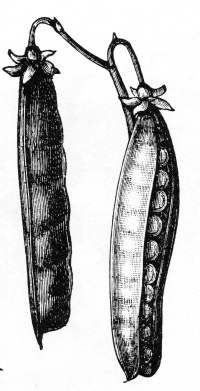A note on pease pudding, or, mariners’ fare in the seventeenth century.
Pease pudding, or pease pottage and sometimes peas porridge, is one of the oldest recipes printed in English and also one of the most prevalent dishes eaten at sea in the seventeenth century. In 1629, John Parkinson wrote that “the poorer sort of people” subsisted on pease pottage during lent. He added: “It is much used likewise at Sea for those of them that go on long voyages, and is for change, because it is fresh, a welcome diet to most persons therein.” Paradisi in Sole, Paradisus Terrestris (London 1629), Dover facsimile published as A Garden of Pleasant Flowers (New York 1976) 524
Parkinson noted that pease pottage often included “hot herbs” like mint, savory and thyme; we usually use dried thyme. Thirty seven years after Parkinson, Robert May published a recipe using bacon and mint:
“Take the best old pease you can get, wash and boil them in fair water, when they boil scum them, and put in a piece of interlarded bacon about two pound, put in also a bundle of mince [sic], or other sweet herbs; boil them not too thick, serve the bacon on sippets in thin slices, and pour on the broth.” The Accomplish’t Cook (London 1660) 95
Sippets are toast; May’s use of ‘mince’ is not really a typographical error. ‘Mint’ frequently appears in the plural in seventeenth century books and manuscripts, and spelling was not yet uniform. Parkinson, for example, refers to “Mints.”
Recipes for pease pudding are simple. Some use a hambone or hock instead of Mays’ bacon or omit the meat in favor of butter but the basics are the same.
Pease pudding. If you want to make this pudding but have forgotten to soak the peas, proceed anyway. Add another couple of cups of water to the stockpot and simmer the pudding longer. Four servings.
 -about ¼ lb roughly chopped bacon
-about ¼ lb roughly chopped bacon
-1 ½ cups dried peas, rinsed, soaked overnight and drained.
-2 quarts water
-heaped teaspoon dried thyme
-unsalted butter
- Render the bacon in a heavy pot, then add the water, peas and bacon.
- Bring the pudding to a hard boil, reduce it to a simmer, partially cover the pot and cook the pudding until it thickens and the peas are soft, usually 2 ½ to 3 hours.
- Puree the pudding with an immersion blender, or simply mash it up, and serve each portion with a dollop of butter.
Notes:
- Use common sense and add water if your pudding threatens to scorch.
- The oldest recipes use yellow peas; the more commonly available green ones have appeared by the eighteenth century and are equally appropriate.
- It is not strictly authentic to use ham or pork stock instead of water but it makes a very, very nice pease pudding. Do not salt your stock, and be careful if it is ham, unless you omit the bacon from the recipe.
- Shredded ham instead of butter to finish the pudding is a pleasant option; so is a sprinkling of minced fresh parsley, which, however, you were unlikely to have to hand at sea in the seventeenth century.

